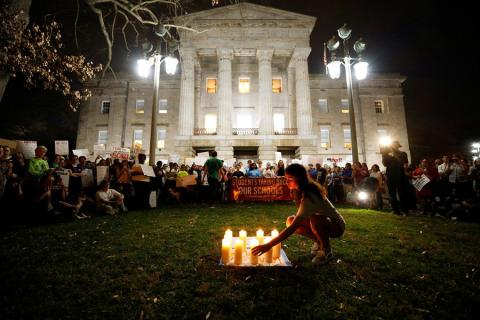There are two big lies going around in the wake of the Parkland school shooting last week. They are the same two big lies that go around every time one of these tragic events occurs. The first is that we can keep this from happening again just by passing a few laws about guns. We can't. The idea that people who want to break laws will find ways to get guns to break laws is not entirely wrong. Legislation is a blunt instrument not a magic wand.
The second lie is that we can find a way to solve the problem of mass shootings without even considering changes to our gun laws. This is the fallacy that causes people to look at every aspect of the problem except the easy availability of firearms. Changes in laws both reflect and drive changes in culture, and it makes no sense to take every possible legal solution off the table before you even start the conversation. More often than not, this is a delaying tactic: stall until the national grief subsides and then do nothing.
We have to do something. The murder of children in their schools is not acceptable. And the effects of these shootings goes far beyond the tragedies they cause in people's lives. All of our children are affected by the feeling that they are not safe in their schools. This is how terrorism works. Mass shooters are terrorists.
We can solve this problem--or, at least, we can dramatically reduce its frequency. But it won't be easy. It will take a national consensus that school shootings are unacceptable and a sustained national effort on all fronts: new laws, better enforcement of old laws, targeted ad campaigns to encourage reporting, efforts to decrease bullying and social alienation, increased surveillance, heightened awareness, and hard, hard work.
I have seen this approach work twice in my life--each time, Americans came together and collectively decided that something was unacceptable and then changed it. The first of these happened when I was in high school in the early 1980s.
In 1982, 5,215 people under the age of 21 were killed in drunk driving accidents in the United States. In 2016, the number was 1,031--despite a 35% increase in overall population. This is still far too many, but we have manged to cut the incidents of alcohol-related traffic deaths among young people by 80%--and the rate for all people by more than 50%.
But this didn't just happen. It was part of a sustained campaign on multiple fronts: drinking ages were raised, state by state to 21. DUI penalties were increased. Police set up check points. Schools incorporated anti-drunk driving materials into their driver's education curriculum. People set up ride share programs. And the entertainment industry started to send the message that "friends don't let friends drive drunk." And all of this was the direct result of political activism by the Mothers Against Drunk Driving (MADD)--ordinary women who lost their children and then decided to change the world.
The second time a sustained effort to change a culture worked was in 2001. When terrorists hijacked three airplanes and turned them into weapons of mass destruction, America collectively said "Never Again" and meant it. Until that time, airline hijacking was a fairly common problem in the world. It happened with frightening regularity in the 1960s, 1970s, and 1980s, and was not unknown in the 1990s.
But in 2001, we got really serious about airline safety. We changed the way we travel. We gave up some of our freedom to run through airports. We started taking off our shoes every time we fly. Lines got longer and we had to throw away a lot of perfectly good toiletries. And we changed a number of our laws to allow closer surveillance of possible terrorists.
And it worked. No American airline has been hijacked since September 11, 2001, and incidents internationally are virtually unheard of. We solved the problem, but we had to change to do it. Laws were a part of the change, but ultimately only a small part. We had to change our habits.
School shootings should affect us the same way. But one effect of our highly polarized public sphere is that we don't seem to have enough in common to even frame the debate that we need to have. In this debate, nothing permissible under the Constitution should be off the table. And the courts have made it very clear that the Constitution will permit a number of restrictions on the sale, ownership, and transportation of firearms.
But this does not mean that they are all good ideas or that they will all work. Some of them won't. But none of them will work if we do no more than pass laws and then move on to the next thing. We have to change attitudes and behaviors too. We have to change a culture, and, while laws are part of culture, they are not the only part. And they are much easier to change than hearts and minds.
Changing a culture is hard work. But we can do hard things. We have done hard things. We owe it to our children to do them again. We need to say "never again" and mean it.
